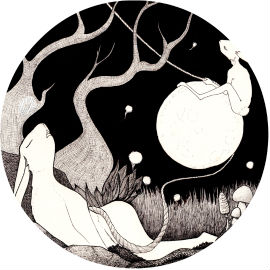Recently, Gyspy Thornton blogged about the notion of fairy-tale mixtapes, an idea borrowed from Adam Hoffman’s discussion of Andrew Lang, and how to conceptualise the eccentric array of works pulled together in Lang’s coloured fairy tale collections. The always sparkly and scholarly Rebecca-Anne do Rozario blogged her fairy-tale mixtape here.
The idea is to take inspiration from Andrew Lang who, as Adam Hoffman argues, Lang is a DJ!:
If the books of other fairy tale collectors are essentially albums, then Lang is the guy who takes tracks from all these different albums and puts them together into epic fairy tale playlists. Sometimes it’s familiar hits you know. Other times it’s stuff you’ve never heard of. Sometimes he’ll just surprise the heck out of you by including something crazy like Gulliver’s Travels. Every color fairy tale book is the equivalent of a fairy tale mixtape (or mix CD or iPod playlist depending on your generation) all set to rock your weekend.
Want to play along? I do!
So, here’s the idea: you want to pull together a list of up to 20 tales that include works everyone would recognise as fairy tales, but also push at the boundaries of the genre, borrowing, adapting, mixing and muddling. In pulling together my own mixtape, I’ve included plenty of contemporary tales, as well as older tales. I’ve been disrespectful and eccentric, choosing tales I enjoy for one reason or another. It’s my party, and I’ll have hedgehogs and cross-dressing and swans and mermaids, giants and gun-toting daughters of Russian priests. Thanks!

Still from Yozhik v tumane (1975)
Here’s my mixtape, in no particular order:
- Ezhik v tumane (Hedgehog in the Fog) a 1975 Slavic film, by Yuriy Norshteyn. Because, HEDGEHOGS! As Margaryta Golovchenko notes in her introduction to hedgehogs as ‘keepers of order and knowledge in Slavic tales’:
- Hedgehog is the bridge between the conscious and the dream world, evoking sympathy from the audience as they watch him lost in a thick mist, chasing after the mirage of a white horse in the clouds.
- Hans Christian Andersen’s ‘The Wild Swans’
- Alexis Wright’s The Swan Book (link is to a good lengthy review/discussion in Sydney Review of Books).
- Urashima Taro (this link is to a version published by Yei Theodora Ozaki, in English, in 1908)
- ‘Belle-Belle ou Le Chevalier Fortuné‘ by Marie-Catherine d’Aulnoy. Because who doesn’t love cross-dressing, late-seventeenth century dames?
- Kelly Link’s ‘Stone Animals’ or ‘The Faery Handbag’, or both!
- ‘Once I wished up a coat / wearing a man inside’, which is collected in The Wishing Bone Cycle: a series of translations of Swampy Cree tales told by Jacob Nibenegenesabe, and translated by Howard Norman. (I’ve posted a little extract and some contextual information here)
- ‘Vasilissa the priest’s daughter’, from Afanas’ev’s Narodnye russkie skazki (Russian Fairy Tales). (She used to dress in male fashion, used to sit astride on horseback; shot with her gun, and did nothing like other girls …)
- Angela Carter’s ‘Ashputtle or the Mother’s Ghost: Three Versions of One Story’
- ‘Richilde’ by Johann Karl August Musäus, or maybe his ‘Der geraubte Schleier’ (The Stolen Veil – link is to the tale in German. I’m working on a translation!), which is said to be one of the sources of Tchaikovsky’s ballet Swan Lake. Both tales were first published in German (1782-1786) in his Volksmärchen der Deutschen (German Folktales). Like the Grimms, he was a collector rather than a writer (like Andersen), but took even more liberties with the works he collected than the infamous brothers. His works are, to an extent, much more like contemporary literary fairy tales in the way that they borrow, mix, and hybridise sources into new works.
- ‘Semerssauq’ an Inuit tale included in Angela Carter’s Virago Book of Fairy Tales.
- Sofia Samatar’s ‘Selkie Stories are for Losers’

Imogen in her bed-chamber where Iachimo sees the mole under her breast. painting by Wilhelm Ferdinand Souchon, 1872
- Het Lied van Heer Halewijn (The song of Lord Halewijn) The link is to a Dutch version, with notes. Translation to come!) is a traditional Dutch ballad, usually just referred to as Heer Halewijn. So, you know, I have to include it or my Oma will come back to eat my bones! Alan Garner included an English version/adaptation in his 1975 collection, The Guizer: A Book of Fools.
- ‘The History of Jack and the Giants’ from Peter and Iona Opie’s The Classic Fairy Tales. Because giants! Also, because it’s one of the only truly British tales (see Wanning Harries excellent tracing of the history of British fairy tales). Because who could resist teaching your children and your lovers to chant: Fee, fi, fo fum, / I smell the blood of an Englishman. / Be he alive, or be he dead, / I’ll grind his bones to make my bread.
- William Shakespeare’s Cymbeline, King of Britain.
- Emma Donoghue’s ‘The Tale of the Shoe’ (from Kissing the Witch)
- Anne Sexton’s ‘The Twelve Dancing Princesses’ (If you danced from midnight / to six A. M. who would understand?)
- ‘Fable’ by Charles Yu
- ‘I Am Anjuhimeko’ by Hiromi It? (collected in Bernheimer’s My Mother She Killed Me, My Father He Ate Me)
- Karen Joy Fowler’s ‘Halfway People’
Which tales would be in your coloured fairy book/mixtape?


[…] I posted my personal mixtape of fairytale and folklore selections: an eccentric list of fairy tales, folktales and other works, inspired (in the collating) by the […]